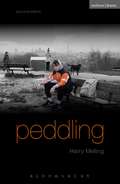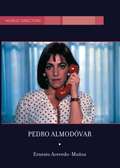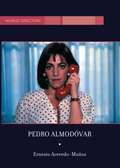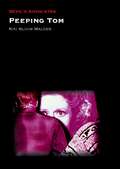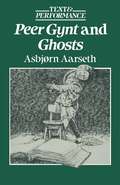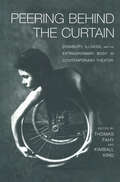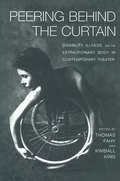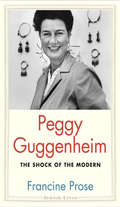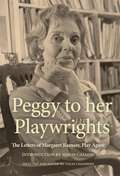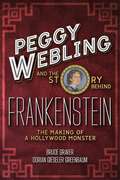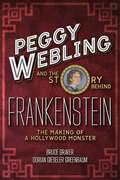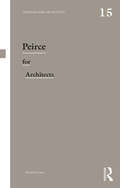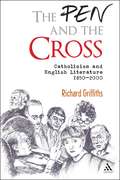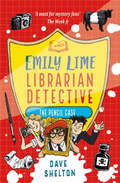- Table View
- List View
peddling: Ditch; Peddling; The Big Meal; Lampedusa (Modern Plays)
by Harry Mellingif I was gold almighty himself,and destroyed this first attempt at life.what would my second version be?. . . a dead end of endless possibility.A pedlar boy wakes up in a field somewhere in London, surrounded by the remnants of the night before. With no memory of how he has come to be there, he knows he must go back to the start in order to understand it all. His attempts to retrace events from the previous days lead him on a haunting journey where everything comes into question: his life, his world, his future.peddling is Harry Melling's remarkable debut play following a day in the life of a door-to-door salesman as he battles difficult questions and attempts to come to terms with the resulting truths.peddling received its world premiere at Hightide Festival on 10 April 2014, performed by Harry Melling, before transferring to 59E59 Theatre, NY, for a four-week run. It was revived in 2015 by HighTide at the Arcola Theatre, London.
The Pedestrian and the City
by Carmen Hass-KlauThe Pedestrian and the City provides an overview and insight into the development, politics and policies on walking and pedestrians: it includes the evolution of pedestrian-friendly housing estates in the 19th century up to the present day. Key issues addressed include the struggle of pedestrianization in town centers, the attempts to create independent pedestrian footpaths and the popularity of traffic calming as a powerful policy for reducing pedestrian accidents. Hass-Klau also covers the wider aspects of urban and transport planning, especially public transport, essential for promoting a pedestrian-friendly environment. The book includes pedestrian-friendly policies and guidelines from a number of European countries and includes case studies from the UK, Germany, Britain, France, Spain, Italy, the Netherlands, Denmark, the US and Canada, with further examples from ten additional countries. It also contains a unique collection of original photographs; including ‘before’ and ‘after’ photos of newly introduced pedestrian-friendly transport policies. As the pedestrian environment has become ever more crucial for the future of our cities, the book will be invaluable to students and practicing planners, geographers, transport engineers and local government officers.
The Pedestrian and the City
by Carmen Hass-KlauThe Pedestrian and the City provides an overview and insight into the development, politics and policies on walking and pedestrians: it includes the evolution of pedestrian-friendly housing estates in the 19th century up to the present day. Key issues addressed include the struggle of pedestrianization in town centers, the attempts to create independent pedestrian footpaths and the popularity of traffic calming as a powerful policy for reducing pedestrian accidents. Hass-Klau also covers the wider aspects of urban and transport planning, especially public transport, essential for promoting a pedestrian-friendly environment. The book includes pedestrian-friendly policies and guidelines from a number of European countries and includes case studies from the UK, Germany, Britain, France, Spain, Italy, the Netherlands, Denmark, the US and Canada, with further examples from ten additional countries. It also contains a unique collection of original photographs; including ‘before’ and ‘after’ photos of newly introduced pedestrian-friendly transport policies. As the pedestrian environment has become ever more crucial for the future of our cities, the book will be invaluable to students and practicing planners, geographers, transport engineers and local government officers.
Pedro Almodovar (World Directors)
by Ernesto R. Acevedo-MunozThe book provides a detailed introduction to the essential themes, style, and aesthetics of Pedro Almodovar's films, put in the context of Spain's profound cultural transitions since 1980. With precise and close analysis, the book covers the major concerns of the most successful of all Spanish film directors and makes direct, clear connections to the logic of Almodovar's aesthetic and stylistic choices. By spanning the entirety of Pedro Almodovar's feature making career, the book emphasizes the director's sensibility to make the outrageous believable and to always give a unique spin to the issues Spanish history, culture and identity. A detailed and comprehensive approach to all of Pedro Almodovar's feature films from the outrageous 1980 'Pepi, Luci, Bom and Other Girls on the Heap' to the sophisticated 2004 'Bad Education', this book provides more than an introduction an intimate look at the topics, style, aesthetics and cultural sensibilities of Spain's most distinguished and celebrated film director since Luis Bunuel. By focusing on a film-by-film, and often scene-by-scene analysis, this book offers a meticulous interpretation of characters, situations, allusions and cultural intersections, as well as emphasizing the meaning and weight of cultural, historical and social contexts. The book traces the evolution of Almodovar's career, from the perspective of aesthetic, narrative and stylistic concerns and places those changes in the logical context of Spain's historical trajectory from the end of Franco's dictatorship to the transition to democracy, exploring Almodovar's interest on issues of identity, sexuality, and nationalism.
Pedro Almodovar (World Directors)
by Ernesto R. Acevedo-MunozThe book provides a detailed introduction to the essential themes, style, and aesthetics of Pedro Almodovar's films, put in the context of Spain's profound cultural transitions since 1980. With precise and close analysis, the book covers the major concerns of the most successful of all Spanish film directors and makes direct, clear connections to the logic of Almodovar's aesthetic and stylistic choices. By spanning the entirety of Pedro Almodovar's feature making career, the book emphasizes the director's sensibility to make the outrageous believable and to always give a unique spin to the issues Spanish history, culture and identity. A detailed and comprehensive approach to all of Pedro Almodovar's feature films from the outrageous 1980 'Pepi, Luci, Bom and Other Girls on the Heap' to the sophisticated 2004 'Bad Education', this book provides more than an introduction an intimate look at the topics, style, aesthetics and cultural sensibilities of Spain's most distinguished and celebrated film director since Luis Bunuel. By focusing on a film-by-film, and often scene-by-scene analysis, this book offers a meticulous interpretation of characters, situations, allusions and cultural intersections, as well as emphasizing the meaning and weight of cultural, historical and social contexts. The book traces the evolution of Almodovar's career, from the perspective of aesthetic, narrative and stylistic concerns and places those changes in the logical context of Spain's historical trajectory from the end of Franco's dictatorship to the transition to democracy, exploring Almodovar's interest on issues of identity, sexuality, and nationalism.
Peeping Tom (Devil's Advocates)
by Kiri WaldenReviled on its release, Peeping Tom (1960) all-but ended the career of director Michael Powell, previously one of Britain's most revered filmmakers. The story of a murderous cameraman and his compulsion to record his killings, Powell's film stunned the same critics who had acclaimed him for the work he'd made with writer-producer Emeric Pressburger (The Life and Death of Colonel Blimp, 1943; A Matter of Life and Death, 1946), resulting in the film falling out of circulation almost as soon as it was released. It took the 1970s 'Movie Brat' generation to rehabilitate the director, and the film, which is now regarded as a masterpiece. In this Devil's Advocate, published to coincide with the film's 60th anniversary, Kiri Walden charts the origins, production and devastating critical reception of Peeping Tom, comparing it to the treatment meted out to its contemporary horror classic, Alfred Hitchcock's Psycho (1960).
Peeping Tom (Devil's Advocates)
by Kiri WaldenReviled on its release, Peeping Tom (1960) all-but ended the career of director Michael Powell, previously one of Britain's most revered filmmakers. The story of a murderous cameraman and his compulsion to record his killings, Powell's film stunned the same critics who had acclaimed him for the work he'd made with writer-producer Emeric Pressburger (The Life and Death of Colonel Blimp, 1943; A Matter of Life and Death, 1946), resulting in the film falling out of circulation almost as soon as it was released. It took the 1970s 'Movie Brat' generation to rehabilitate the director, and the film, which is now regarded as a masterpiece. In this Devil's Advocate, published to coincide with the film's 60th anniversary, Kiri Walden charts the origins, production and devastating critical reception of Peeping Tom, comparing it to the treatment meted out to its contemporary horror classic, Alfred Hitchcock's Psycho (1960).
Peer Gynt and Ghosts: Text and Performance (Text and Performance)
by Asbjorn AarsethA study of two of Henrik Ibsen's most impressive and frequently- performed dramatic texts, the dramatic poem Peer Gynt and the concentrated prose play Ghosts, whose appearance caused an uproar when first performed. In the first half of the book, the author pays particular attention to the imagery patterns of Ibsen's language; Peer Gynt is considered in its cultural context, and Ghosts with reference to Ibsen's concept of drama. Recent productions of both plays are considered in detail, including the Young Vic production of Ghosts in 1986.
Peer Mentoring in Music Education: Developing Effective Student Leadership
by Andrew GoodrichPeer Mentoring in Music Education: Developing Effective Student Leadership offers a practical guide to peer mentoring in music education, enabling music teachers to implement and benefit from this technique with their students. Drawing on extensive and current research in education and music education, the core focus of this book is on the instructional practice of peer mentoring and how students can become effective leaders. Through case studies and examples focused on music education, the author shows how peer mentoring can transform learning for all students and foster student leadership as part of a student-centered instructional approach. Part I explores the foundations of these instructional practices, the role of the music teacher, the role of the student, and how socializing and student leadership contribute to meaningful learning. Part II portrays stories of four exemplary music teachers who use peer mentoring and student leadership in their music programs across a wide array of age levels and music classes and ensembles. Music teachers will benefit from learning about the transformative power of peer mentoring and student leadership, and how these instructional practices aid with diversity, equity, inclusion, and access so that all students are valued in the music class and ensemble. Peer Mentoring in Music Education: Developing Effective Student Leadership provides a comprehensive guide for in-service and preservice music teachers seeking to understand peer mentoring and incorporate this technique in teaching.
Peer Mentoring in Music Education: Developing Effective Student Leadership
by Andrew GoodrichPeer Mentoring in Music Education: Developing Effective Student Leadership offers a practical guide to peer mentoring in music education, enabling music teachers to implement and benefit from this technique with their students. Drawing on extensive and current research in education and music education, the core focus of this book is on the instructional practice of peer mentoring and how students can become effective leaders. Through case studies and examples focused on music education, the author shows how peer mentoring can transform learning for all students and foster student leadership as part of a student-centered instructional approach. Part I explores the foundations of these instructional practices, the role of the music teacher, the role of the student, and how socializing and student leadership contribute to meaningful learning. Part II portrays stories of four exemplary music teachers who use peer mentoring and student leadership in their music programs across a wide array of age levels and music classes and ensembles. Music teachers will benefit from learning about the transformative power of peer mentoring and student leadership, and how these instructional practices aid with diversity, equity, inclusion, and access so that all students are valued in the music class and ensemble. Peer Mentoring in Music Education: Developing Effective Student Leadership provides a comprehensive guide for in-service and preservice music teachers seeking to understand peer mentoring and incorporate this technique in teaching.
Peer Play and Relationships in Early Childhood: International Research Perspectives (International Perspectives on Early Childhood Education and Development #30)
by Avis Ridgway Gloria Quiñones Liang LiThis book offers a rich collection of international research narratives that reveal the qualities and value of peer play. It presents new understandings of peer play and relationships in chapters drawn from richly varied contexts that involve sibling play, collaborative peer play, and joint play with adults. The book explores social strategies such as cooperation, negotiation, playing with rules, expressing empathy, and sharing imaginary emotional peer play experiences. Its reconceptualization of peer play and relationships promotes new thinking on children's development in contemporary worlds. It shows how new knowledge generated about young children's play with peers illuminates how they learn and develop within and across communities, families, and educational settings in diverse cultural contexts. The book addresses issues that are relevant for parents, early years' professionals and academics, including the role of play in learning at school, the role of adults in self-initiated play, and the long-term impact of early friendships. The book makes clear how recent cultural differences involve digital, engineering and imaginary peer play. The book follows a clear line of argument highlighting the importance of play-based learning and stress the importance of further knowledge of children's interaction in their context. This book aims to highlight the narration of peer play, mostly leaning on a sociocultural theoretical perspective, where many chapters have a cultural-historical theoretical frame and highlight children's social situation of development. Polly Björk-Willén, Linköping University, Sweden
Peering Behind the Curtain: Disability, Illness, and the Extraordinary Body in Contemporary Theatre (Studies in Modern Drama #18)
by Thomas Fahy Kimball KingFirst Published in 2002. Routledge is an imprint of Taylor & Francis, an informa company.
Peering Behind the Curtain: Disability, Illness, and the Extraordinary Body in Contemporary Theatre (Studies in Modern Drama)
by Kimball King Tom FahyFirst Published in 2002. Routledge is an imprint of Taylor & Francis, an informa company.
Peggy Guggenheim: The Shock of the Modern (Jewish Lives)
by Francine ProseOne of twentieth-century America’s most influential patrons of the arts, Peggy Guggenheim (1898–1979) brought to wide public attention the work of such modern masters as Jackson Pollock and Man Ray. In her time, there was no stronger advocate for the groundbreaking and the avant-garde. Her midtown gallery was the acknowledged center of the postwar New York art scene, and her museum on the Grand Canal in Venice remains one of the world’s great collections of modern art. Yet as renowned as she was for the art and artists she so tirelessly championed, Guggenheim was equally famous for her unconventional personal life, and for her ironic, playful desire to shock. Acclaimed best-selling author Francine Prose offers a singular reading of Guggenheim’s life that will enthrall enthusiasts of twentieth-century art, as well as anyone interested in American and European culture and the interrelationships between them. The lively and insightful narrative follows Guggenheim through virtually every aspect of her extraordinary life, from her unique collecting habits and paradigm-changing discoveries, to her celebrity friendships, failed marriages, and scandalous affairs, and Prose delivers a colorful portrait of a defiantly uncompromising woman who maintained a powerful upper hand in a male-dominated world. Prose also explores the ways in which Guggenheim’s image was filtered through the lens of insidious antisemitism.
Peggy Guggenheim (Text Only): The Life Of An Art Addict
by Anton GillThis edition does not include illustrations. Please note that due to the level of detail, the family tree is best viewed on a tablet. The wayward life (1898–1979) of the voracious art collector and great female patron of world-famous artists.
Peggy to her Playwrights: The Letters of Margaret Ramsay, Play Agent
by Colin Chambers Peggy RamsayPeggy Ramsay (1908-1991) was the foremost play agent of her time. Her list of clients shows her to have been at the centre of British playwriting for several generations from the late 1950s on.To her remarkable array of clients, her letter writing was notorious, marked by searing candour, both a wondrous motivation and an unforgiving scrutiny to be feared.'Peggy judged by the most exalted standards and lashed her writers when they failed to meet them. Her force of personality made her well-nigh irresistible. The letters she wrote to her writers and to producers are extraordinary documents, filled with all these qualities, and indiscreet, blasphemous and saucy to boot.’ – Simon Callow
Peggy Webling and the Story behind Frankenstein: The Making of a Hollywood Monster
by Peggy Webling Dorian Gieseler Greenbaum Professor Bruce GraverThe 1931 Universal Pictures film adaptation of Frankenstein directed by James Whale and starring Boris Karloff as the now iconic Monster claims in its credits to be 'Adapted from the play by Peggy Webling'. Webling's play sought to humanize the creature, was the first stage adaptation to position Frankenstein and his creation as doppelgängers, and offered a feminist perspective on scientific efforts to create life without women, ideas that suffuse today's perceptions of Frankenstein's monster. The original play script exists in several different versions, only two of which have ever been consulted by scholars; no version has ever been published. Nor have scholars had access to Webling's private papers and correspondence, preserved in a family archive, so that the evolution of Frankenstein from book to stage to screen has never been fully charted. In Peggy Webling and the Story behind Frankenstein, Dorian Gieseler Greenbaum (Webling's great grandniece) and Bruce Graver present the full texts of Webling's unpublished play for the first time. A vital critical edition, this book includes: - the 1927 British Library Frankenstein script used for the first production of the play in Preston, Lancashire - the 1928 Frankenstein script in the Library of Congress, used for productions in UK provincial theatres from autumn 1928 till 1930 - the 1930 Frankenstein Prompt Script for the London production and later provincial performances, held by the Westminster Archive, London - Webling's private correspondence including negotiations with theatre managers and Universal Pictures, family letters about the writing and production process, and selected contracts - Text of the chapter 'Frankenstein' from Webling's unpublished literary memoir, The Story of a Pen for additional context - Biography of Webling that bears directly on the sensibilities and skills she brought to the writing of her play - History of how the play came to be written and produced - The relationship of Webling's play to earlier stage and film adaptations - An exploration of playwright and screenwriter John L. Balderston's changes to Webling's play and Whale's borrowings from it in the 1931 film Offering a new perspective on the genesis of the Frankenstein movie, this critical exploration makes available a unique and necessary 'missing link' in the novel's otherwise well-documented transmedia cultural history.
Peggy Webling and the Story behind Frankenstein: The Making of a Hollywood Monster
by Peggy Webling Dorian Gieseler Greenbaum Professor Bruce GraverThe 1931 Universal Pictures film adaptation of Frankenstein directed by James Whale and starring Boris Karloff as the now iconic Monster claims in its credits to be 'Adapted from the play by Peggy Webling'. Webling's play sought to humanize the creature, was the first stage adaptation to position Frankenstein and his creation as doppelgängers, and offered a feminist perspective on scientific efforts to create life without women, ideas that suffuse today's perceptions of Frankenstein's monster. The original play script exists in several different versions, only two of which have ever been consulted by scholars; no version has ever been published. Nor have scholars had access to Webling's private papers and correspondence, preserved in a family archive, so that the evolution of Frankenstein from book to stage to screen has never been fully charted. In Peggy Webling and the Story behind Frankenstein, Dorian Gieseler Greenbaum (Webling's great grandniece) and Bruce Graver present the full texts of Webling's unpublished play for the first time. A vital critical edition, this book includes: - the 1927 British Library Frankenstein script used for the first production of the play in Preston, Lancashire - the 1928 Frankenstein script in the Library of Congress, used for productions in UK provincial theatres from autumn 1928 till 1930 - the 1930 Frankenstein Prompt Script for the London production and later provincial performances, held by the Westminster Archive, London - Webling's private correspondence including negotiations with theatre managers and Universal Pictures, family letters about the writing and production process, and selected contracts - Text of the chapter 'Frankenstein' from Webling's unpublished literary memoir, The Story of a Pen for additional context - Biography of Webling that bears directly on the sensibilities and skills she brought to the writing of her play - History of how the play came to be written and produced - The relationship of Webling's play to earlier stage and film adaptations - An exploration of playwright and screenwriter John L. Balderston's changes to Webling's play and Whale's borrowings from it in the 1931 film Offering a new perspective on the genesis of the Frankenstein movie, this critical exploration makes available a unique and necessary 'missing link' in the novel's otherwise well-documented transmedia cultural history.
Peirce for Architects (Thinkers for Architects)
by Richard CoyneIdeas gain legitimacy as they are put to some practical use. A study of Charles Sanders Peirce (1839-1914) supports this pragmatism as a way of thinking about truth and meaning. Architecture has a strong pragmatic strand, not least as we think of building users, architecture as a practice, the practical demands of building, and utility. After all, Vitruvius placed firmness and delight in the company of utilitas amongst his demands on architecture. Peirce (pronounced 'purse') was a logician, and so many of his ideas are couched in terms of formal propositions and their limitations. His work appeals therefore to many architects grappling with the digital age, and references to his work cropped up in the Design Methods Movement that developed and grew from the 1950s. That movement sought to systematise the design process, contributing to the idea of the RIBA Plan of Work, computer-aided design, and various controversies about rendering the design process transparent and open to scrutiny. Peirce’s commitment to logic led him to investigate the basic elements of logical statements, notably the element of the sign. His best-known contribution to design revolves around his intricate theory of semiotics, the science of signs. The study of semiotics divided around the 1980s between advocates of Peirce’s semiotics, and the broader, more politically charged field of structuralism. The latter has held sway in architectural discourse since the 1980s. Why this happened and what we gain by reviving a Peircean semiotics is the task of this book.
Peirce for Architects (Thinkers for Architects)
by Richard CoyneIdeas gain legitimacy as they are put to some practical use. A study of Charles Sanders Peirce (1839-1914) supports this pragmatism as a way of thinking about truth and meaning. Architecture has a strong pragmatic strand, not least as we think of building users, architecture as a practice, the practical demands of building, and utility. After all, Vitruvius placed firmness and delight in the company of utilitas amongst his demands on architecture. Peirce (pronounced 'purse') was a logician, and so many of his ideas are couched in terms of formal propositions and their limitations. His work appeals therefore to many architects grappling with the digital age, and references to his work cropped up in the Design Methods Movement that developed and grew from the 1950s. That movement sought to systematise the design process, contributing to the idea of the RIBA Plan of Work, computer-aided design, and various controversies about rendering the design process transparent and open to scrutiny. Peirce’s commitment to logic led him to investigate the basic elements of logical statements, notably the element of the sign. His best-known contribution to design revolves around his intricate theory of semiotics, the science of signs. The study of semiotics divided around the 1980s between advocates of Peirce’s semiotics, and the broader, more politically charged field of structuralism. The latter has held sway in architectural discourse since the 1980s. Why this happened and what we gain by reviving a Peircean semiotics is the task of this book.
The Pen and the Cross: Catholicism and English Literature 1850 - 2000
by Richard GriffithsThis incisive and perceptive new book concerns 'Catholic Literature' in Britain since 1850. To many people, Roman Catholicism is culturally foreign and 'other'. And yet some of the most outstanding writers of recent times have been Catholics - often converts, such as Evelyn Waugh, Graham Greene, Muriel Spark and David Jones. In every case these authors' Catholicism was integral to their creative genius and they represent an important strand in any account of English literature. Professor Griffiths' account is set against a wide and varied canvas. It gives a full account of the growth of Catholicism as a cultural, social and political force in Great Britain since Newman. Griffiths is concerned also to relate his story to movements on the continent and examines on his way the impact of French Catholic writers such as Huysmans, Peguy and Mauriac on their British counterparts and the influence of British Catholic writers such as Newman, Faber and Chesterton on Europe.
The Pen and the Cross: Catholicism and English Literature 1850 - 2000
by Richard GriffithsThis incisive and perceptive new book concerns 'Catholic Literature' in Britain since 1850. To many people, Roman Catholicism is culturally foreign and 'other'. And yet some of the most outstanding writers of recent times have been Catholics - often converts, such as Evelyn Waugh, Graham Greene, Muriel Spark and David Jones. In every case these authors' Catholicism was integral to their creative genius and they represent an important strand in any account of English literature. Professor Griffiths' account is set against a wide and varied canvas. It gives a full account of the growth of Catholicism as a cultural, social and political force in Great Britain since Newman. Griffiths is concerned also to relate his story to movements on the continent and examines on his way the impact of French Catholic writers such as Huysmans, Peguy and Mauriac on their British counterparts and the influence of British Catholic writers such as Newman, Faber and Chesterton on Europe.
Pen and Wash: An artist's guide to combining ink and watercolour
by John HarrisonPen and Wash is a practical guide to creating a picture that captures the discipline of pen, along with the subtlety of watercolour. With clear instruction and inspirational examples throughout, it explains the conventional approach of drawing and then adding wash, but also explores alternative ideas and styles. The author's passion for the technique is evident in his examples and enthusiastic text, making the book a superb guide to this beautiful medium. Advise on the correct equipment, techniques, the unpredictable nature of watercolours and Step by step demonstrations of pen and wash techniques.
Pen & Ink: Tattoos and the Stories Behind Them
by Wendy MacNaughton Isaac FitzgeraldWhy did you get that tattoo?Every tattoo tells a story, whether the ink is meaningful or the result of a misguided decision made at the age of fourteen, representative of the wearer's true self or the accidental consequence of a bender. These most permanent and intimate of body adornments are hidden by pants legs and shirttails, emblazoned on knuckles, or tucked inside mouths. They are battle scars and beauty marks, totems and mementos. Pen & Ink grants us access to the tattoos-and the stories behind them-of writers Cheryl Strayed and Roxane Gay; rockers in the bands Korn, Otep, and Five Finger Death Punch; and even a porn star. But it also illuminates the tattoos of the ordinary people living in our midst-from professors to thrift store salespeople, cafe owners to librarians, union organizers to administrators-and their extraordinary lives.Curated and edited by Isaac Fitzgerald, who sports twelve tattoos himself, each story "is like being let in on . . . secrets by . . . strangers who passed you on the street or sat across from you on the train†? (Strayed) and features Wendy MacNaughton's gorgeously rendered full-color illustrations of the tattoos on black-and-white drawings of the bearer's body. At its heart, beneath its colorful skin, Pen & Ink is an exploration of the decision to scar one's self with a symbol and a story.
The Pencil Case (Emily Lime: Librarian Detective)
by Dave SheltonIt's a new term at St Rita's School for Spirited Girls, and there are new mysteries for Emily, Daphne and George to solve!Who has stolen a painting from Pilkington Art Gallery? (And why? It's not even a very good one!)How can they get rid of a new headmistress who theatens the very future of the library?And why are there cows all over the sports field?Expect the unexpected as Emily Lime investigates!
